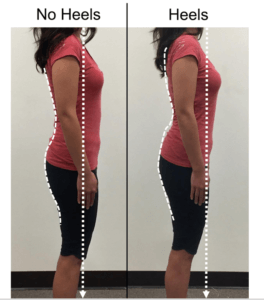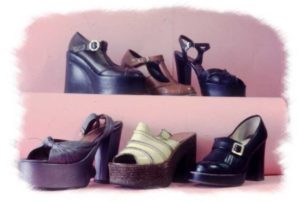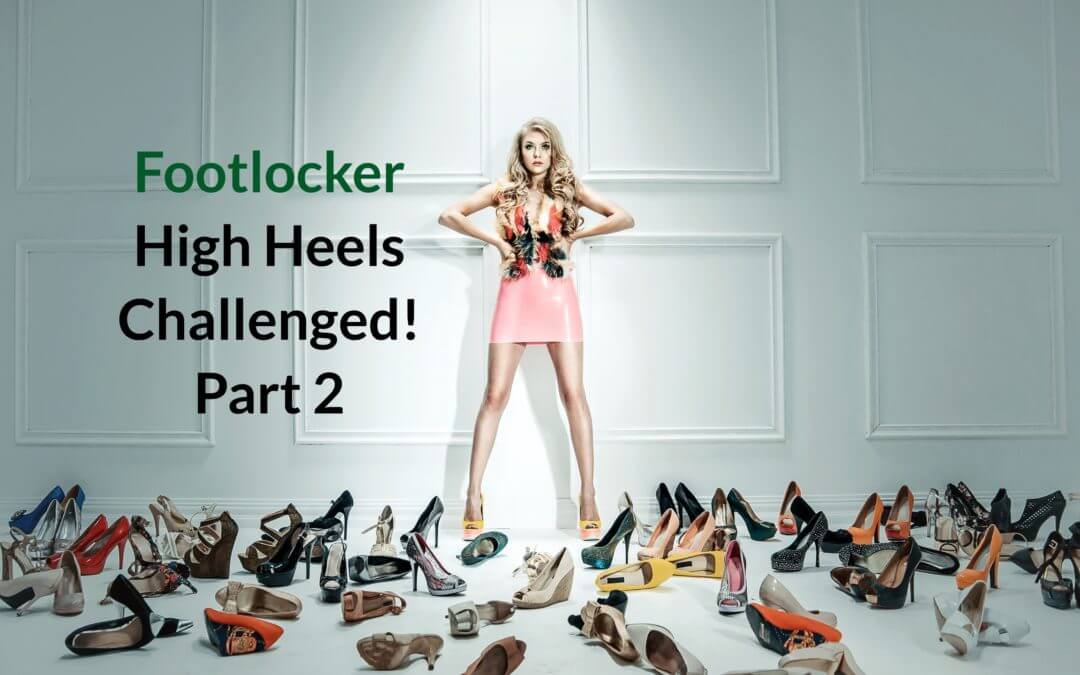‘High Heels Challenged!’
Welcome to ‘challenging high heels’.
In researching the subject, I noticed that recent interest in high heels is waning. Is there a case for banning high hells? Material on the subject stretches back to the late 20th century and the first decade of the 21st. Newspaper reports form the bulk of opinions from journalists, mostly female, but not entirely. There is no shortage of evidence written from every standpoint. In the second part of my article on high heels, I want to look a little more at the science. That said, I prefer to keep things simple.
The case for safety
The TUC and Health Safety Executive, both UK organisations, have published guidelines on footwear safety. Perhaps more than anything, safety lies at the top of the list of concerns by podiatrists committed to good foot health. Researchers at Aberdeen University carried out a review of scientific studies into shoes. Data revealed that while high heels increased women’s attractiveness to men, studies also showed that injury and conditions associated with the body’s muscles, joints and bones were at risk. Collectively, these are called musculoskeletal conditions. Researchers contrasted the response of the UK Government with that of the Canadian province of British Columbia, which had previously changed the law to ban employers from requiring female staff to wear high heels. Our mind goes back to Nicola Thorpe, where I discussed her fate in Part 1 when her bosses forced her to wear high heels at Portico in 2017.
Max Barnish, at Aberdeen University, considered that despite the huge amount of evidence against heels, complex social and cultural reasons competed with risks. Heather Morgan, a lecturer at the same university, believed that the message was not telling people not to wear high heels but to provide information so those users could judge the health risks and social benefits. The lawmakers need to change the legislation in the UK, while this has already happened in Canada. No one in the workplace or a licensed public social venue should be made to wear such footwear.
Real data
In Australia between 2006-10, Williams & Haines (2014) reported that 240 injuries had been recorded in a Victoria emergency department where 98% were women and younger than 55 years. Injuries occurred mostly on Sundays between 8 am-12 pm in 1/3 of cases. The winter season had a greater incidence, and the ankle was the most common site. Research between 2002 and 2012 at the University of Alabama showed results from high-heeled-shoe findings mirrored the Australian study’s injuries, again taken from a hospital emergency department. McGwin in the Alabama paper (Journal of Foot and Ankle Injuries) was cited by Shepard pointing again to younger people suffering.
People between the ages of 20 and 29 were most likely to suffer an injury, followed by the 30-39 age group. Bob Shepard 2015
While we can use reports from newspaper incidents as case histories, why not? This is evidence; it is always useful to look at the academic side of the subject. Put simply, this means ethically approved with controlled studies.
Posture and feet
 The spine shape changes as heels influence the hip, and some might argue this makes the feminine outline more attractive as the buttocks are accentuated. Lewis et al. (2017) noted that the lumbar spine forms a greater curve. The picture was taken in Lewis 2017 (Frontiers in Psychology accessed from the internet 7/8/19). The author has drawn lines to show the curvature change and centre of gravity line (CoG). If the body’s CoG moves forward, the back muscles have to work harder, and this causes the lower curve (lumbar) to become accentuated. Depending upon the heel height, the CoG will alter through the foot. If weight is distributed crudely at 50:50, although Broega (2017) is 43% on the ball of the foot and 57% under the hindfoot, the elevated heel increases the forefoot pressure above half that pressure as the heel rises. Women’s attraction to high heels has evolved over time, and a research project used 82 men to study photographs of female attractiveness. Lewis and co-workers (2017) looked at the evolution of high heels, the effect on the spine and the attractiveness of certain shoe designs in this study.
The spine shape changes as heels influence the hip, and some might argue this makes the feminine outline more attractive as the buttocks are accentuated. Lewis et al. (2017) noted that the lumbar spine forms a greater curve. The picture was taken in Lewis 2017 (Frontiers in Psychology accessed from the internet 7/8/19). The author has drawn lines to show the curvature change and centre of gravity line (CoG). If the body’s CoG moves forward, the back muscles have to work harder, and this causes the lower curve (lumbar) to become accentuated. Depending upon the heel height, the CoG will alter through the foot. If weight is distributed crudely at 50:50, although Broega (2017) is 43% on the ball of the foot and 57% under the hindfoot, the elevated heel increases the forefoot pressure above half that pressure as the heel rises. Women’s attraction to high heels has evolved over time, and a research project used 82 men to study photographs of female attractiveness. Lewis and co-workers (2017) looked at the evolution of high heels, the effect on the spine and the attractiveness of certain shoe designs in this study.
In 2010, Blanchette and co-workers published an academic paper in Gait & Posture, a formal scientific journal. The study used 15 healthy women who wore high heels. Three heel heights were used, and the forces were measured. These included the downward or vertical force from gravity. However, they were interested in the forces that run parallel to the sole and the potential for causing changes due to friction.
As the heel height increased, the vertical forces dropped by 12%, but the frictional shear forces increased by the same amount. As our centre of mass moves forward so does the line of gravity. Hip and knee flexion increases. In other words, there was a trade-off in position for a shift in forces. We need a certain amount of friction to push our foot forward, but in the wrong place, added to an unstable heel, that friction works against our human frame, which is less stable than a four-legged animal. That centre of mass is easy to push outside the imaginary white line, and when that happens, you fall. The only safeguard is a walking stick or crutch!
Height effect on the foot
The effect of the foot, ankle, and musculoskeletal design causes ankle muscle movement to reduce. The step length, the total range of ankle movement and balance control are all altered. The strain on the muscles and tendons of the lower leg can lead to musculoskeletal disorders later in life. While most injuries affected the ankle or foot, nearly 20 per cent involved the knee, trunk, shoulder, or head and neck. More than half were strains or sprains, with fractures accounting for 19 per cent of all injuries. McGwin’s (with other authors) study noted that nearly half the injuries occurred in the home. In contrast, Williams & Haines found that 19.2%, accounting for most injuries in the study, arose in unspecified places.
From a podiatrist’s viewpoint, extending the toes alone exposes the football to greater damage as the fat pad moves forward, and any existing hammertoe deformity adds to pressure problems. Additional forefoot pressure may not directly cause foot conditions. Still, it will accentuate problems causing callus, corns, and deeper tissue damage like nerve impingement (Morton’s neuroma) and bursa fluid sacs. Cutmore, a podiatrist from New South Wales, advised that the achilles tendon could be slowly destroyed as the tendon is shortened, throwing the body out of balance and straining the knee. The word destroyed is rather emotive, but falling can equally be destructive as the ankle mechanics alter and sprains are well reported from accident department statistics. But it is not just a matter of the height of the heel. We must consider the surface area, which returns to the stiletto heel.
Surface area
 We must draw attention to the surface area of the base of the heel. Something the size of a drawing pin creates far more instability than a wider platform. Elton John led the fashion amongst others for men in the 1970s with shoes called stacks. The heels and soles were built up and answered the shorter man’s concerns for height. These soles had plenty of areas and were stable compared to the ‘stiletto’ design, but they were condemned as unstable. So, we need to be specific about what we are challenging. Design or safety? The TUC has a close relationship with the College of Podiatry concerning employment, and we find their influence in the guidance on footwear at work (Working feet and footwear – www.tuc.org.uk/sites/default/files/footwear.pdf)
We must draw attention to the surface area of the base of the heel. Something the size of a drawing pin creates far more instability than a wider platform. Elton John led the fashion amongst others for men in the 1970s with shoes called stacks. The heels and soles were built up and answered the shorter man’s concerns for height. These soles had plenty of areas and were stable compared to the ‘stiletto’ design, but they were condemned as unstable. So, we need to be specific about what we are challenging. Design or safety? The TUC has a close relationship with the College of Podiatry concerning employment, and we find their influence in the guidance on footwear at work (Working feet and footwear – www.tuc.org.uk/sites/default/files/footwear.pdf)
As McDonnell says,
concern about the potential impact of wearing high heels on women’s health, and in causing musculoskeletal and long-term foot disorders, have been expressed in medical circles for more than 50 years. Some organisations have called for compulsory wearing of high heels at work to be outlawed.
In 2009, the Society of Chiropodists and Podiatrists (UK) (now the College of Podiatry) made the statement that –
‘Women workers should not be made to adhere to a dress code that can damage their feet and should have the choice to wear footwear that will not leave them prone to long-term foot health problems.’
We will unlikely see a change in the availability of shoe designs that lead to injury. In a world of consumerism, the individual must determine what is right, as evidence is insufficient to condemn shoes. It takes a newspaper event that raises questions in Parliament to tease out the issue of high heels. However, the popularity of heels seems to be on the decline as females prefer flat shoes in some 66% of cases compared to just over 10 per cent who prefer to wear high-heeled shoes.
Surgery, the big toe and high heels
Angela, my patient in Part 1, was driven by the look of her fancy red shoes. First, the shoe’s look, and secondly, because it made her feel good. However, her sizable bunions on both feet would be compressed unless I could help her. As a former podiatric foot surgeon, my role was not to undertake surgery so that she could use high heels afterwards, but that was a risk I would have to take. I have seen a few patients return after surgery and feel disappointed that high heels were not ideal. This is worse when the big toe is surgically stiffened. The effect of surgery should be discussed clearly before the event.
Women should have the last word
It has been suggested that a smaller calf muscle size is achieved by a high heel, which is true. Shapely legs have been the cause of many male catcalls from the heights of scaffolding if we believe the films and adverts of the past. I came across a blog from Augusta McLaughlin on the matter of legs;
Here’s a little secret I wish every woman knew: Our legs don’t need to be elongated, clenched or upheld at a particular angle to be beautiful and embraceable. I’ve thought a lot about this fact since last May when I decided to stop wearing high heels for a year. Variety
McLaughlin (2015,2016) again,
I’ve also learned that high heels cause a whole lot more than a bit of temporary pain. Women should have every right to wear whatever shoes they wish, without judgment…I find it interesting that virtually no articles on high heel risks suggest giving them up as a viable option, much less the one sure way to prevent or minimize these problems.
McLaughlin’s female-driven blogs carry material that is hard to ignore, partly because it has been derived from professional sources. The risks from high heel shoes are emphasised in her article (click here) if you want a list and more information from a predominantly female perspective. As I have never worn the style of shoes women use I am unable to judge the effects, but I know from a scientific point of view that mechanics change with postural shifts created by raising the arch.
Footwear is a personal choice and better scientific study from epidemiological information – on both health effects and on risks to safety from high heel wearing – might actually help women themselves to have more confidence in the shoe choices they make for the workplace.
The key to common sense can be summarised
- Wear the right footwear for the right occasion and setting.
- Reduce the time of exposure and limit the time allocated to wearing heels
- Carry a spare pair of shoes with lower heels for comfort, especially when driving
- Examine heels for damage and fractures before wearing them each time
- Protect skin and bumps from pressure
- Use a small forefoot pad to reduce frictional forces on the forefoot available from pharmacists
- Avoid running in high-heeled shoes. Use the right footwear for the right job
Thanks for reading ‘High Heels Challenged’ by David R Tollafield

Original published 12th August 2019 and modified 19th October 2024


Recent Comments